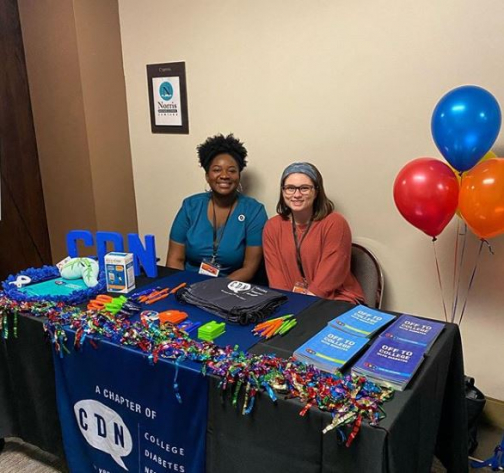A Movement, Not a Moment: About the POC Living with Diabetes Virtual Summit
People of color within the diabetes community have been calling for more representation and have their voices heard from other community members and organizations, alike. While people with diabetes have a lot in common, the experiences of people of color are unique; dealing with issues such as racism, health disparities and how culture impacts the daily diabetes care. Noticing the gap in awareness and storytelling by people of color with diabetes, Quisha Umemba, MPH, BSN, RN, CDCES, CHWI, and Kacey Creel organized and hosted the first-ever People of Color Living with Diabetes Virtual Summit (POCLWD) from August 3rd to August 6th.
With speakers such as Beyond Type 1 and Beyond Type 2 Leadership Council members, Kendall Simmons and Mila Clarke Buckley, who live with diabetes to healthcare professionals such as Lisa Sumlin, the event covered topics such as food/nutrition, exercise, technology and more. Umemba spoke with Beyond Type 2 about how this summit was organized and why it’s more than a moment in the diabetes industry, but a movement.
BT2: Let’s start with your background. Can you tell me a little bit about your expertise in the diabetes field?
I’m a registered nurse and have been practicing for 13 years. I’ve been in the diabetes field for the last eight years and have been certified diabetes care and education specialist (CDCES) for the last five. I started out in the endocrinology clinic, which is kind of funny because I hated endocrinology in nursing school. I really didn’t understand when I went to go to work there, that the majority of my patients would have diabetes. So, that’s where my love, not only for diabetes started but also for public and community health.
Previously, I worked doing inpatient care where I didn’t have very much interaction with the patients or their families. I didn’t have the opportunity to make an impact on one’s health or lifestyle as much. I noticed that I could actually do that working in outpatient or community care.
A fun fact about me is that I considered not renewing my CDCES certification in December later this year.
Why did you consider not renewing your certification?
I considered not renewing it because as sometimes relationships go, I actually fell out of love with diabetes. I got to a place where I no longer trusted the process, no longer trusted the organizations, no longer trusted the association, no longer felt heard, or valued or important. I didn’t feel like I was supported, especially from the organizations and associations that should be supporting me as an educator. If they weren’t supporting me, there was no way they were supporting the patient or the client.
I started looking at things from a global perspective and noticing what I coined as an “illusion of help;” there are actually far more barriers to care, certainly to diabetes care and education, such as affordability, coverage and location, than there needs to be. People, especially underserved patients, deserve to get the kind of care they need. I felt like I needed to do something else to get back into diabetes.
What is the People of Color Living with Diabetes Summit, how it came to be and how you met Kacey Creel?
In trying to fall back in love with diabetes, I reached out to the College Diabetes Network (CDN) and signed up to be an ambassador for them or volunteer. I asked them if they had any events in Austin, Texas, where I live. They said they would be attending the JDRF Type One Summit in March [2020] and needed volunteers. I was told I’d be there with one of their student volunteers at the CDN table. That’s where I met Kacey Creel, CEO of Type One Tools.
We were both manning the table together for about six to eight hours and I loved her sweet personality. We hit off right away. But I noticed at this particular conference that there was no representation from people of color. I live in Austin, Texas; I’m not a stranger to going somewhere and there being only one or two Black people—there’s less than 8 percent of Black people here in the city.
However, we know people of color have the worst health outcomes when it comes to diabetes. I thought that it was a really poor effort on behalf of the JDRF organization to not have one Black or brown speaker. There were no attendants that were Black or brown and there were two vendors there representing local organizations, myself and one other person.
Kacey and I spent probably four out of six of those hours talking about the lack of representation, healthcare disparities, outcomes in people of color and what we can do about it. She told me her story about her background and how she really wasn’t exposed to diversity until she went to college, which happened to be an HBCU (historically Black college or university).
So, she really was being self-aware and wanting to do the work and create opportunities for people of color to share those stories. I also have a business Umemba Health LLC, where I provide continuing education and professional development for frontline health workers virtually. She suggested it would be cool to do something virtually and I told her about my experiences holding virtual summits. But, I’ll be very honest with you, never in a million years did I think Kacey was so serious about doing it. With me, if I say I’m going to do it, I’m going to do it. But you don’t meet a lot of other people that share that same quality.
Four weeks after the summit, she sent me a text telling me she was still interested in putting together an event where people could have the opportunity to share their experiences. At the end of May, we started planning the People of Color Living with Diabetes Virtual Summit and started sending out emails asking if people were interested in being speakers.
Can you tell us about some of the pertinent issues you thought it was important to cover at the summit?
That’s a good question. I thought it was important that we allow people the opportunity to just be heard. I think a lot of times for people of color, their experiences are invalidated or disregarded. We wanted to offer a safe space, not only for people to share and be heard, but we also wanted our viewers to be able to see people that looked like them and shared similar experiences. This event needed to really resonate with real everyday people.
We also wanted to focus on self-advocacy. I know for me as a member of the Black community, a lot of times we take the information that the doctor gives us, we don’t question it, we don’t ask if there are other treatment options, what are my alternatives, etc? If I asked my grandmother, “What medications are you taking?” Most likely she’ll say, “the yellow pill.” I’ll ask her, what is it for? And she’d most likely reply she didn’t know, only that the doctor prescribed it. “For me, a big part of the POCLWD Summit was empowering people to be self-advocates. And for letting them know, you have a right to ask questions and to speak up for yourself. You deserve quality healthcare and asking questions and speaking up for yourself is how you can make sure you get it.
Another goal was to create the awareness that people have different experiences and we wanted to give the opportunity for people outside of Black or brown communities the opportunity to develop empathy and compassion. When we talk about allies or friends, we need them to understand, this is what it’s like for us on a daily basis. Not only are we living while Black or brown in America right now, but we have to be Black and brown every day and live with diabetes. That’s another layer of complexity.
Kacey and I also talked about other issues that need to be discussed—such as the inclusion of Black and brown people in research. We have a speaker presenting a research study that was done with Black people, as it relates to diabetes self-management education. Sadly, there are so many people with diabetes who don’t even understand what diabetes self-management education means.
We also wanted people to understand what an insulin pump and a continuous glucose monitor (CGM) are, hear what they do and know it’s a treatment option available to them. This summit was about promoting awareness, creating community, letting our stories be heard and providing that safe space for people to do so. I know a lot of people in the diabetes community have not felt free to be vocal about their experiences.
How do you plan on making sure people don’t forget that this summit happened and continue to spread the word after it’s over?
I’m so glad you asked me that question. Our summit had several sponsors. With that sponsorship money, we’re starting a nonprofit organization. Without giving too much away, we are actually going to continue to do this work on a full-time basis going forward. Kacey and I call this the first annual People of Color Living With Diabetes summit because it won’t be the last. We want to have an organization or foundation that can provide year-long community support groups, virtual classes, etc. We want to partner and collaborate with other organizations to help create this awareness and help find ways to address healthcare disparities so that we can improve the health of our Black and brown populations. We are going to keep this momentum going. This is a movement, not a moment.
For the larger diabetes and public health organizations, what do you want them to take away from this summit? You and Kacey were able to put this together in just a few short months. What’s your message to them?
Simple, there is no excuse.
I’ve known Kacey since March of this year. We started planning the Summit at the end of May and in less than 60 days, she and I were able to put this event together. There is no excuse. Organizations that have been in existence for years and have the money and resources to do so could have done something like this before now. Again, there’s just no excuse. What do I want to say to those organizations? Email us so we can talk about how we can work together. We can be reached at poclwdiabetes@gmail.com
To watch the People of Color Living with Diabetes Summit, catch all of the sessions here on YouTube.
Related Content:
How I Empower Minorities to Live Well with Diabetes






